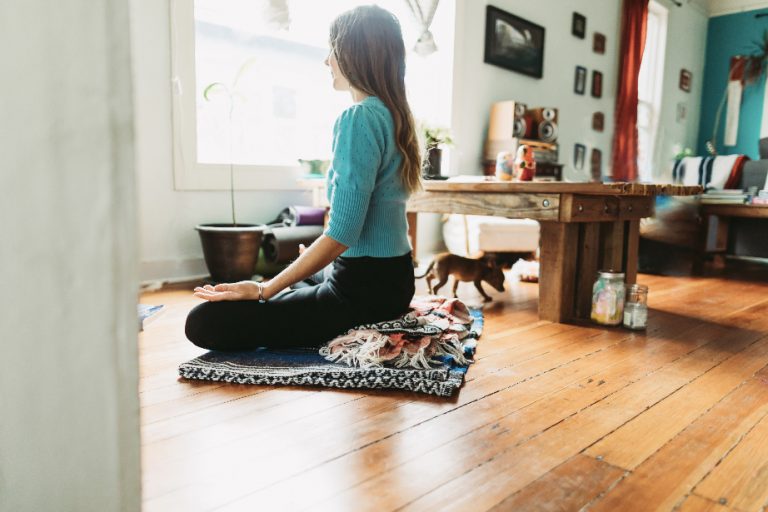Myth 2: You need to sit completely still to meditate
Going for a walk, run or a hike are all perfectly good opportunities to meditate. These aren’t options for everyone, as some feel more comfortable staying home for the time being, but it may still help to keep this in mind.
You can even meditate while walking your dog. Instead of using the time to catch up on phone calls or check text messages, “pay attention to the temperature and how the wind is blowing, and noticing and smelling flowers that are in bloom,” Milligan says. “Nature is very grounding and so spending time in nature, whether it’s a walk or hiking or just sitting in the backyard, is very meditative.”
Myth 3: You can’t think any thoughts while meditating
The form of meditation that requires clearing your mind of all thoughts and sitting still for an extended period of time frankly just doesn’t work for everyone.
“After talking with friends, family, and colleagues about meditation, I found that many people have this idea that meditation requires complete stillness in your mind and body – you’re sitting there, your eyes are closed, you’re quiet and you’re not supposed to think about anything,” Milligan says. “That’s not really what meditation is, at least not for me.”
For Milligan, meditation is less about clearing her mind of thoughts and more about having an awareness of her thoughts, along with her body, her breath, and bringing her focus to the present moment.
“It’s common to go through most of our day being unaware of thoughts, feelings, and emotions,” Milligan says. “Meditation allows us to slow down and bring awareness to thought patterns or emotions that may be operating on auto-pilot.”
In bringing awareness to these patterns through meditation, she adds, you can learn how to manage and respond (rather than react) to them in a healthy way.
Myth 4: You need a quiet room to meditate
Milligan turned her spare bedroom into a meditation/yoga/exercise studio, and has a friend who converted a closet to keep her kids out while she’s meditating, but not everyone has that extra space.
It’s really just about having a visual reminder for your brain to leave work, or childcare, or whatever mode it’s in to be able to focus on the meditation. This visual reminder can be anything from a designated room or corner to a favorite comfy chair to a pillow or cushion – whatever will signal to your brain to go into meditation mode.
Having an environment that’s pin-drop quiet isn’t necessary either. If you do have a space that’s perfectly noiseless, that’s great, but if you don’t, it won’t ruin your experience. Listening to a guided meditation or playing music in the background can help with that focus, Milligan points out.
Hearing noises and bringing your attention back to your breath, rather than being distracted by them, can actually be helpful for your practice. After all, one of the results of meditation is learning to stay present in the moment when life throws curveballs your way. Noises that occur while you’re meditating can help you learn to steer your focus.
“We can never really create a perfect environment where there’s no distraction and no noises, but that’s not the point of meditation, because that’s not real life,” Milligan explains. “In life there will always be things we can’t control, but instead of getting frustrated, we can remember how connecting to our breath during meditation helps us remain calm even when we are surrounded by chaos.”
Myth 5: You need to commit a chunk of time per day to meditate
“I think that’s the hardest part about meditation,” Milligan says of committing time to daily practice. “I’m not perfect. I don’t meditate every day and I should meditate more – but it’s not something you have to be perfect at and that’s what I love about it.”
Generally, the more time you spend meditating the more it can help you, but not everyone has the time or dedication to do it on a daily basis, and that’s OK. Milligan aims for three times a week.
Similarly, it isn’t necessary to spend a half-hour each day meditating. Try starting with two minutes per day and work up from there. But if you only have a few seconds, that can work too. “Sometimes I feel like I don’t have time to meditate and so I’ll just close my eyes and take five deep breaths and that helps calm my mind and my anxiety,” Milligan notes.
The most important thing is to not let meditation become a source of negative self-talk and a reason to criticize yourself.
“Meditation is a practice of self-compassion and forgiveness,” Milligan says. “It’s that practice of forgiveness and letting go of perfection that translates into our everyday life.”






